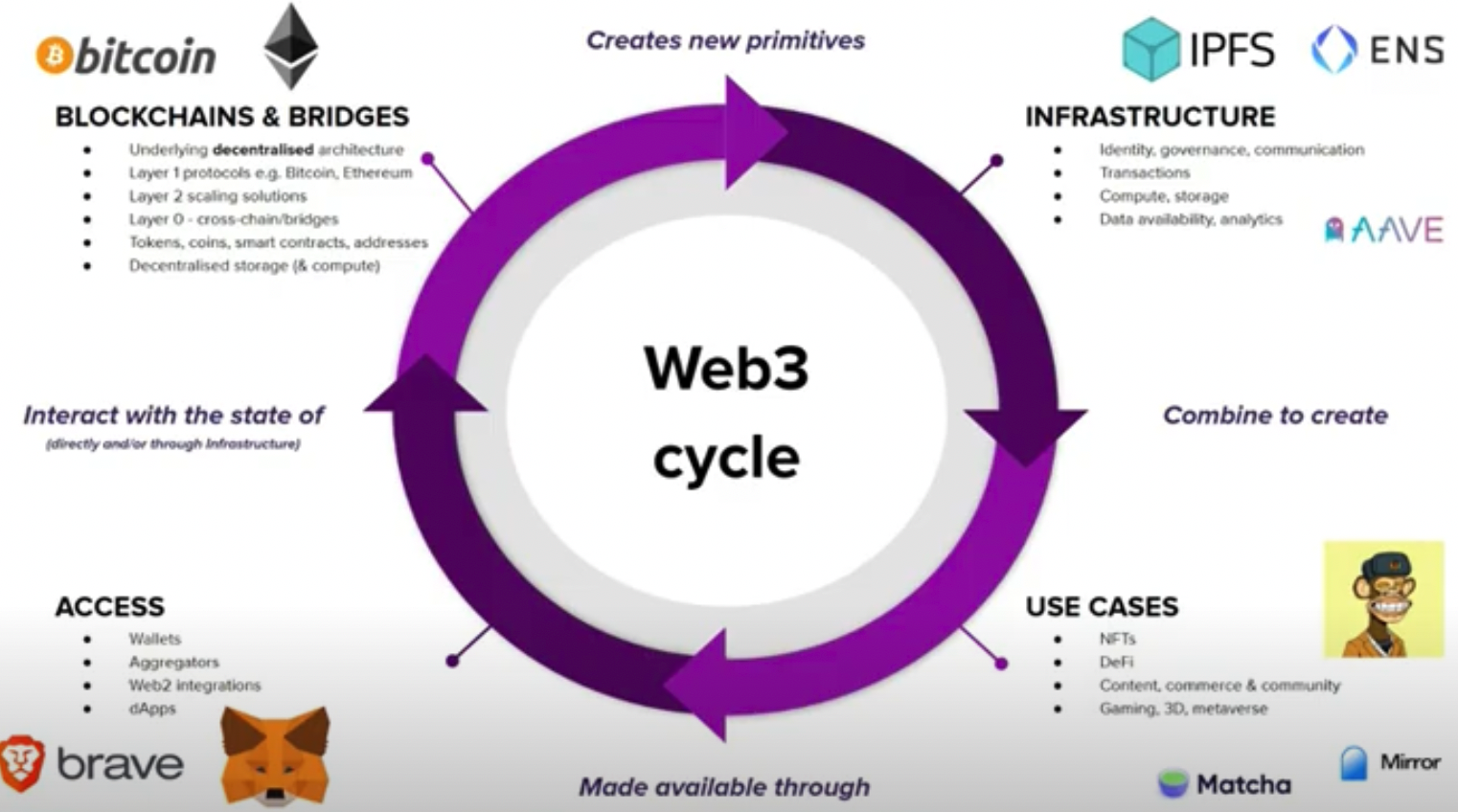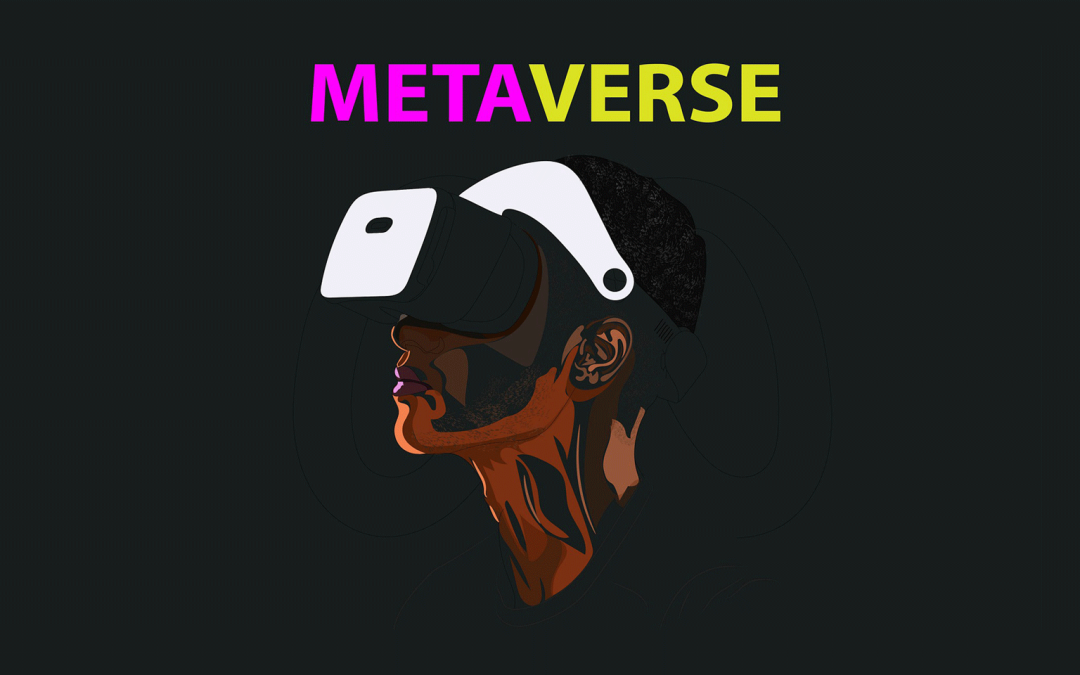The Blockchained Society: Web 3.0, Virtual Reality and the Network State
There is a willingness in this world for people to adopt new things because they are told to do so. There is also a willingness for people to sit back and let the course of human evolution be decided for them.
Who said that merging with AI is inevitable? It’s only inevitable if we decide to do it. If we made a collective decision to start picking berries and hunting deer with bows and arrows, we could do that, too.
The idea of inevitability has been programmed into us. It’s form of brainwashing. Nonetheless, as a society, we are on the precipice of a revolution – a change so big that it could irreversibly alter the very structure of human society and the way we form relationships, as well as completely redefine the nature of transaction and exchange.
Yes, I’m talking about the “metaverse”, the blockchain, decentralised cryptocurrencies, and the thing that started it all – Bitcoin.
But to understand how all of these things fit together, it’s necessary to first examine “Web 3.0” – what it is, how it’s being marketed and how it will affect us.
Web 3.0: The Next Iteration of the Internet
Unless you work in tech you’ve probably never heard the term “Web 3.0” before (also written as “web3”).
To understand web3, a quick history lesson is in order: When the internet was first made available it was “read-only”, in other words, it made information available to the public but in static format; regular people did not have the know-how to publish new content, as this required technical expertise and deep knowledge of code. This initial form of the internet, we will call “web1”.
The next iteration of the internet, which we experience today, allows regular users to both read content and publish it. With “web2”, the internet became interactive, paving the way for the creation of social networks, allowing users to connect and create.
The problem with web2 is that information is controlled by central authorities that collect and productise it. In exchange for the ability to create, we’ve allowed large corporations to establish ownership over our personal data.
That brings us to “web3” which seeks to solve the problems created by web2 while also providing the infrastructure for new, disruptive technologies.
The idea is that “Web3” will be:
- Decentralised (i.e., no organisations will control your data);
- Permissionless (anyone may access the network);
- Uncensorable (content that’s been published cannot be altered or removed);
- Monetisable (creators can be paid for the value they create, without a middleman);
- Private (identity is encrypted and anonymity is optional).
Sounds good, but how will this be achieved? The idea is that the internet will be rebuilt so as to restructure it around blockchain and cryptocurrencies.
You see, money is an age-old medium of exchange that has been in use for centuries. In fact, the concept of money hasn’t changed much over time, although it may be physically different than it was in the past. But up until now, money has been absent as a protocol that forms part of the internet.
This will change with Web3. The idea is that by integrating money into the structure of the internet itself, we can rid the online world of invasive advertising that relies on the mass collection of private data as well as shatter the power of authoritative, big tech monopolies.
“Web3” will see the internet undergo a massive restructuring, and it will be built on the following 4 “layers”:
1. The Blockchain (the Base Layer)
Underlying everything on web3 is the blockchain: a shared ledger run by a decentralised network of peer-to-peer nodes (the same technology that powers Bitcoin and Ethereum).
The blockchain is not owned or controlled by anyone and it cannot be found on a single server. Rather, copies of the blockchain are stored across thousands of participants on the network. Think of it like a decentralised database of transactions.
However, in order to maintain consistency, security and objectivity, each node (participant) much reach an agreement about the network’s current state. This agreement is achieved algorithmically using a consensus mechanism, such as proof-of-work or proof-of-stake.
Proof-of-work (PoW) is done by “miners”, who compete to verify new transactions and add them to the chain as “blocks” (hence, blockchain). The winner shares the new block with the rest of the network and earns cryptocurrency as a reward. The race is won by the computer which is able to solve a math puzzle fastest – this produces the cryptographic link between the current block and the block that went before. Solving this puzzle is the “work” in “proof-of-work”.
Proof-of-stake (PoS) is done by validators who have staked their own cryptocurrency to participate in the network. A validator is chosen at random to verify transactions and create new blocks. They then share them with the rest of the network and earn rewards. Instead of needing to do intense computational work, validators put up cryptocurrency as collateral for agreeing to strengthen the chain. This is what incentivises healthy network behaviour.
In order to defraud such a system you’d either need to control 51% of the computational power of the entire network (in the case of PoW), or you’d need to own 51% of the total staked cryptocurrency (in the case of PoS). This makes the system “trustless”, in that the cost of manipulating the system would outweigh any benefit gained by doing so.
The final thing to understand about the blockchain is that it’s a public ledger; in other words, anyone can view it and see the transaction history of the entire network. However, in order to write to the blockchain, you need to transact, i.e., you need to pay. And that’s where cryptocurrency comes in.
2. Decentralised infrastructure
The second “layer” of web3 is the infrastructure that sits on top of the blockchain. You see, the blockchain enables the creation of decentralised infrastructure, and this will form the backbone of the digital, web3 ecosystem. This includes decentralised storage, exchanges, communication systems, social networks and more.
3. New ways to engage
Web3 infrastructure leads to new use cases for the internet. In other words, there will be new ways for people to engage with one another, earn money online and entertain themselves. This includes the creation and selling of “NFTs”, new ways to conduct commerce, decentralised communities, gaming, and yes, the “metaverse”.
A quick word is needed about NFTs. NFT stands for “Non-fungible token” (i.e., something that’s one-of-a-kind); they are basically digital collectibles that are stamped onto the blockchain. They can also represent real-world items (this is important). The introduction of NFTs has resulted in jpegs of apes being worth hundreds of thousands of dollars.
People have even begun to mint real-life animals as tradable NFTs (I’ll let you mull over the significance of that yourself). In short, NFTs will form the basis for ownership in the metaverse (of which more soon).
4. Access
The final “layer” of web3 will be the access layers, which are the means by which participants will access the system. Right now, we experience the internet through applications and websites. With web3, users will access the internet using these same means together with decentralised apps and crypto wallets.

With web3 comes a strange dichotomy between freedom and enslavement. On the one hand, it could lead to a free internet, ungoverned by authorities, and uncensorable, where everyone has the ability to transact freely, without the need for third parties.
On the other hand, many people that promote web3 as being an uncensorable utopia are the same people promoting “programmable” currencies and the “metaverse” – two concepts utterly adverse to the notion of a free society.
After all, for a currency to be “programmable”, somebody must be doing the programming. This brings us back to the promotion of CBDCs (Central Bank Digital Currencies) and what researcher James Corbett refers to as “the Bitcoin PsyOp”; i.e., promotion of the idea that cryptocurrencies and blockchains are all created equal (they’re not!).
Like most things in life, the effect that web3 will have on society will depend on how we use it. In my mind, web3 has the potential to grant freedom or enslave us all. If implemented in the right way, it may well be the globalist kryptonite. On the other hand, it may also be used by the very same elites to construct a digital dictatorship.
We only need to look at the organisations investing in web3 to know that it’s not all sunshines and rainbows: Facebook is investing in digital wallets with “Novi”, MasterCard are planning to support crypto transactions and Blackrock is now trading Bitcoin futures… that doesn’t exactly fill you with hope about the future of crypto, does it?
And while there are many examples of web3 initiatives that would have you clapping your hands and pumping your fists in support, there are an equal number of such projects that would have you hanging your head in despair or slamming your palm squarely into your forehead as you shudder with disgust.
For example, there are a number of web3 projects seeking to unite the seemingly disparate world’s of crypto and climate. The idea? By tokenising carbon credits, i.e., bringing them onto the blockchain, and thereby removing them from the market, the real-world carbon price inflates, incentivising corporations to adopt “greener” practices. This is one such example of how web3 and climate are uniting to help drive the creation of new (scammy) markets.
There are more examples but this is not the place for a deep dive into the murky waters of crypto-environmentalism. Rather, we will turn our attention to an equally worrying offshoot of web3, one that is being actively driven by one of the most evil and powerful organizations in the world: Facebook’s “Metaverse”.
What Is the Metaverse?
The term “metaverse” was first used by futurist and Science fiction writer, Neal Stephenson in his 1992 book Snow Crash to describe a “theoretical” 3D virtual reality that ordinary people could occupy.
Noteworthy is that Stephenson worked at Jeff Bezos’ spaceflight company, Blue Origin for seven years during the early 2000s when the company’s focus was on developing “alternate” propulsion systems (an interesting job for a novelist, wouldn’t you agree?). He was later hired by Magic Leap, a Florida-based “augmented reality” company, but left in 2020.
A deeper look at Stephenson’s work reveals some interesting themes, for the list of topics explored in his books reads like the meeting agenda from a closed session at Davos; climate change, global pandemics, biological warfare, nanotechnology, geo-engineering, robotics, cryptography, virtual reality, the list goes on.
In fact, not only has Stephenson written about the “metaverse” before it became a thing, but some people even credit his 1999 book Cryptonomicon with sketching the basis for the concept of cryptocurrency!
Like certain science fiction writers before him, Stephenson is clearly privy to more than he lets on. And his close relationships with billionaire technocrats like Bezos and Gates only fuel my suspicions that he’s not merely a novelist with a good imagination and an uncanny knack for predicting the future.
But alas, we must return to the topic at hand – the metaverse, a virtual world where
you can go about many of your everyday life’s day-to-day interactions and occurrences – in your avatar form. This form can be a human, animal, or something more abstract with its customizable appearance.
Yes, that’s right. You can be whatever you want to be. Your avatar (a word popularised by Stephenson!) could be a boy, girl, dog, buffalo, toaster – anything you like!
You can then interact with other people’s avatars in this virtual world. In the Metaverse, you can buy and sell land, attend concerts and go to museums, build a house, and more.
As the work of Neal Stephenson shows, the “metaverse” is not a new idea. The concept has been gradually leaked into mainstream culture over the last twenty plus years. Just think of video games like Second Life and movies like The Matrix or Ready Player One.
It was only last year (2021) that Facebook rebranded as “meta”, positioning itself for a future in which it will play a leading role in developing the infrastructure to realise the metaverse.
Still not sure how this all fits together? Simple: With a virtual world like the “metaverse” comes virtual money and virtual goods, i.e., cryptocurrency and NFTs. Without cryptocurrency, the metaverse would not be possible.
The Meta-Economy: Will it Truly be Decentralised?
Web3 itself has the potential to drastically overhaul the global economy in many ways, one of which is through the adoption of truly decentralised currencies as an alternative to central bank issued money-as-debt.
However, as I alluded to before, the other possibility is a world governed by centrally issued “digital currencies”, controlled, tracked and programmed by the powers that be.
Although the metaverse is being marketed as a “decentralised” universe controlled by its users, that simply isn’t the case. At best it’s a mistake, at worst it’s another example of the “bitcoin PsyOp” at work.
If there were a world where the metaverse, or some form of virtual reality, were going to be beneficial to society, it would have to be spearheaded by transparent and accountable organisations with nothing to gain.
Facebook is hardly that sort of organisation. And joining them in building out the meta ecosystem are several prominent tech players. This will almost certainly ensure a continuation of the centralized, monopolistic practices that have allowed unethical behaviour, such as harvesting of private data, to go largely unchallenged (not to mention the stifling of innovation in the online space).
Cudos envisions a centralised metaverse as being “worse than the most creative dystopias yet conceived”. And I’d have to wholeheartedly agree.
During Facebook’s metaverse release demo, Mark Zuckerberg said that he’s
come to believe that the lack of choice and high fees are stifling innovation, stopping people from building new things and holding back the entire internet community.
Other players in the web3 space called Zuckerberg out for being a hypocrite, rightly pointing out that Facebook itself is the definition of a monopoly, having done exactly what Zuckerberg appeared to be condemning in his speech: stifled competition, and reduced consumer choice.
That said, Facebook is certainly not the only big company investing in the metaverse. In fact, several other big brands have seen the opportunity for massive profit and have gladly jumped aboard the meta-train. Nike, for example, responded by acquiring RTFKT Studios, a virtual shoe company (yes, virtual shoe company), to help them sell shoes in the metaverse.
Adidas were quick to follow suit, creating an NFT collection that sold for over $22 million! But that’s not all. They also bought a plot of land in the metaverse to host virtual parties and events!
As it turns out, virtual real-estate is big business. According to an article published on CNET:
Startling amounts of money are being spent on virtual real estate inside Worldwide Webb Land and other metaverses. In June, a metaverse investment firm called Republic Realm spent $913,000 on a parcel in Decentraland, another metaverse. It was the largest deal of its kind at the time. About six months later, the same firm bought 792 plots in Sandbox, still another metaverse, from video game company Atari for an eye-watering $4.23 million.
Among the global organisations buying plots of land in the metaverse are PwC, JP Morgan, HSBC, and Samsung. Some companies see it as an investment (as excitement over the metaverse grows, the prices of real-estate will go up), while others are simply establishing a presence there or investing in advertising space.
Even Snoop Dogg has gotten in on the action, purchasing a mansion in Sandbox and driving up prices of adjoining real-estate to well over $400,000 (a price that people are willing to pay apparently).
The Philosophical Ramifications of Web3 and Life in a Virtual Reality
While web3 and the metaverse have been the focus of much hype recently, what’s seldom contemplated is the philosophical and moral implications of a society that lives and breathes these technologies.
For example, how will our collective morality be affected if people begin living parts of their life in a virtual reality where they can do “anything” without fear of retribution? Where do we draw the line between “it’s just a game” and “you should go to prison for that”?
These are important questions that require careful consideration. In fact, there have already been reports of people being sexually harassed in VR and the problem is only likely to get worse.
These issues become more concerning when we realise that the metaverse is primarily being marketed to “Gen-Z” (anyone born after 1997), who often spend more than 8 hours online each day and are more embedded in digital culture more than anyone else.
Sadly, a generation that has grown up playing violent video games and having their minds raped by AI algorithms, feeding them all manner of abhorrent videos on TikTok is the perfect target market for VR and other mind-numbing technologies that the transhumanists are desperately pushing on society. It’s almost like they’ve been primed for it.
Quynh Mai, founder and CEO of Moving Image & Content, the Gen Z-centric digital marketing consultancy, describes Gen Z as follows:
They have been living most of their lives digitally since birth: making “friends” through social media, discovering music through Spotify algorithms, building games in Roblox, and buying and selling products literally off the backs of strangers on DePop. They are so comfortable maneuvering in the digital world as it’s built on shared trust and reputation. They understand the importance of nurturing their digital identity, whether it’s their TikTok account or a leaderboard score in a game.
Gen Z in the metaverse have none of the social constraints associated with their physical identities, something unthinkable to every previous generation in history. We have to consider the implications of this from a sociological, philosophical and psychological perspective. How will this affect their personal development?
These are serious concerns that nobody seems interested in tackling.
Furthermore, what if the metaverse is merely a stepping stone towards a far darker reality, one in which you are no longer in the metaverse, but the metaverse is in you?
None other than Elon Musk hinted at this during an interview last year in which he made fun of the metaverse saying he wasn’t sold on the idea of “strapping a screen to his face”.
It gets uncomfortable to have this thing strapped to your head the whole time.
No, Musk’s idea of a virtual reality is far more worrisome, for he for-sees a world in which the “metaverse” is literally implanted into your head via a brain-AI interface.
Long term, a sophisticated Neuralink could put you fully, fully in a virtual reality thing.
(This is a good example of the “transhumanist tiptoe” as I like to call it, where these technologies are slowly integrated into society, each serving as a stepping stone for the next until society finds itself embedded in a digital prison – “having this clunky thing strapped to your head is so cumbersome, why don’t we just insert it into your brain instead?”).
Apart from the concerning philosophical and psychological implications of living life in a VR, web3 brings with it all kinds of new possible futures, some of which may actually be an improvement to the way society currently functions, with its reliance upon corrupt central banks and infiltrated governments.
Futurist and former CTO of Coinbase, Balaji Srinivasan, envisions a world in which the blockchain has allowed online communities to “materialise” into the real world as independent, sovereign states. He calls this concept the “network state” and he defines it as follows:
The Network State is a digital nation launched first as an online community before materialising physically on land after reaching critical mass.
In other words, the “network state”, according to Srinivasan, will be the next version of the nation state. He maintains that, due to the decentralised nature of the blockchain, network states will begin as geographically decentralised communities, connected via the internet.
This community will be made up of regular people who believe in a common cause; it will be a group that is capable of collective action. Eventually, the community will begin to build up its own, internal economy using cryptocurrency.
This will allow them to start holding in-person meet-ups in the real world and eventually crowd-fund apartments, houses and even towns to establish co-living facilities and bring digital community members into the real world.
The final step of the process is for the new community to negotiate diplomatic recognition from pre-existing governments, increasing sovereignty and becoming a true network state.
This leads us to Srinivasan’s more complex definition of the concept:
A network state is a social network with a moral innovation, a sense of national consciousness, a recognized founder, a capacity for collective action, an in-person level of civility, an integrated cryptocurrency, a consensual government limited by a social smart contract, an archipelago of crowdfunded physical territories, a virtual capital, and an on-chain census that proves a large enough population, income, and real-estate footprint to attain a measure of diplomatic recognition.
Srinivasan’s philosophy is an interesting one, and despite being a self-proclaimed transhumanist, he just may have outlined a realistic route to gaining independence from the centrally-controlled, ever-more-authoritarian, world state.
What Is the “Blockchained Society”?
Make no mistake, web3 and the metaverse have the potential to squeeze human consciousness into a digital prison, while the controllers rob the world of everything that’s real.
However, with the advent of web3, it also means there’s a fine line between the development of an authoritarian, transhumanist, money-as-debt, “brave new world” and a world made up of decentralised communities working together for the good of society.
Indeed, web3, cryptocurrencies and the blockchain are going to change society as we known it. But whether that change will be for the betterment or detriment of humanity is up to us.
Does that mean we can allow ourselves to indulge in optimism? Not yet. After all, these are new technologies that aren’t yet well understood.
Having said that… what if decentralized finance does gain a foothold, making centralized banking obsolete? What if web3 leads to censorship resistance platforms that engender freedom and creativity? What if “network states” break out and begin declaring independence from existing control structures?
The possibility of any of those things happening would constitute a massive threat to the Schwabians and their Great Reset, one-world government agenda. And that would go some ways towards explaining the irrationality and down-right craziness that we’ve witnessed over the last few years.
The question is this: will the blockchain allow the creation of a new society, unburdened by monopolistic, centralised authorities, or will it quite literally “chain” us to the corrupt practices of a financial system in which there is no freedom to transact?

















